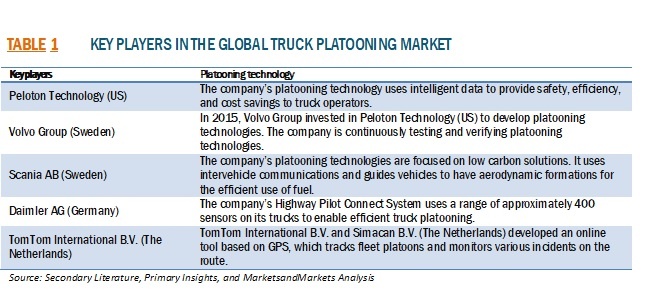 The transportation industry is a vast ecosystem which covers everything related to the major modes of transport, namely, road, rail, marine, and air transport. This industry includes goods as well as passenger transport.
The transportation industry is a vast ecosystem which covers everything related to the major modes of transport, namely, road, rail, marine, and air transport. This industry includes goods as well as passenger transport.
Among all the transportation segments, trucks and buses are the leaders in terms of advancements in technologies and investments from suppliers and original equipment manufacturers (OEMs). According to OICA publications and MarketsandMarkets analysis, global truck production reached 4.02 million units in 2017, up from 3.60 million units in 2015. On the other hand, the global bus production has increased to 429,838 units in 2018, up from 390,466 units in 2015. The increase in the production of trucks and buses is indicative of the rising demand for freight and passenger transport.
It is also estimated that there will be an increase in shipping activities, which would boost the demand for trucking. This, eventually, would result in increased revenue for fleet operators. However, the increased revenues will be accompanied by an expected driver shortage and increased wages and fuel prices. Fluctuating fuel prices, driver shortages, increases in trucking rates, and a possible shortage of trucking capacity will be some of the important challenges the trucking industry will face in the coming years.
In the future, some of the most influential trends in the transportation industry will closely relate to these key challenges. According to MarketsandMarkets analysis, the top transportation industry trends for 2018 include an increasing demand for truck platooning, electric trucks, autonomous driving, electric/hybrid buses, and smart transportation solutions.
1. Truck Platooning
Truck platooning is connecting two or more trucks in a group with the help of connectivity technologies, autonomous driving, artificial intelligence, and support systems such as adaptive cruise control and lane keep assist. The trucks in a platoon automatically keep a set close distance. The truck at the head of the platoon acts as a leader, and the vehicles behind adapt and react to the changes in its movement, requiring little or no action from the driver.
According to the ITS4CV study by Ertico, platooning can improve fuel efficiency and reduce CO2 emissions by up to 16% from the trailing vehicles and by up to 8% from the lead vehicle. Factors such as stringent emission norms, increased fuel efficiency standards, increasing traffic congestion and road accidents, and advancements in AI technologies will together boost the market for truck platooning. Truck platooning can be an effective solution for driver shortages and high wages.
2. Electric Trucks
According to the US Department of Energy (US-DOE), the average vehicle miles travelled (VMT) by class 8 trucks in the US was close to 68,115 miles in 2016. With increasing truck production and freight transportation, the VMT is projected to grow in the coming years. This will eventually increase the CO2 emissions from the trucking industry.
To meet the emissions limits, there is a need for either advanced engine technologies or after-treatment devices. Any of these will lead to increased truck prices. According to a study from EIA, after the implementation of fuel consumption standards in the US, the class 8 truck prices showed an increase of 6.2% between 2014 and 2017. Considering the European and the US CO2 targets and the increasing truck prices, the truck industry is projected to move toward electrification in the next 7–8 years.
As a result, both key players, such as Tesla, Daimler, VW, Waymo-Peterbilt, and Paccar, and new players, such as Orange EV, Einride, Motiv Power Systems, BYD, and Wrightspeed, are investing in R&D of electric trucks. MarketsandMarkets analysis projects the global electric truck market to account for 10–15% of truck sales in various regions, by 2025.
3. Electric/Hybrid Buses
With increasing urbanization around the world, the demand for public transport is growing. The majority of the city buses and coaches are diesel-driven, which add to a country’s CO2 emissions. Many countries from the European region, the US, and others have set CO2 emissions targets to be achieved by 2020–2025.
Considering both these factors, battery electric bus (BEB) and buses with alternate fuel (hybrid buses) will be needed. However, the upfront cost of BEB would be the primary restraint for this transition, as the BEBs cost approximately 100% higher than diesel-powered buses. Alternatively, the introduction of hybrid buses, either diesel-electric, CNG (converted from diesel)-, or biofuel-powered, would be much easier as they are not costly as BEB.
Unification of private and public financiers can be a key solution to the cost concern. Presently, BEBs and hybrid buses are operating mostly in the US, Europe, and China. Brazil and India also have started with electric and hybrid public transport. Even though the global bus market is dominated by diesel-powered buses, followed by hybrid-electric and alternate fuel buses, with the advancements in technology (such as integrated eAxle, wireless charging, and regenerative braking) the demand for BEBs is projected to grow at the fastest rate in coming years.
4. Intelligent Public Transportation
An ideal public transport system can be a single-stop solution for problems such as increasing fuel prices, traffic congestion, and increasing GHG emissions. Governments, OEMs, and technology providers are now focusing on integrated mobility solution. With this system, the first-mile and last-mile problem will be taken care of by a station-based mobility solution, and intra-city and intercity transport will be managed by buses and high-speed trains and metros.
The platform used for an integrated mobility solution will include everything from searching for a journey, mode of transport, checking the schedule, bookings, routing, and payment. In intelligent public transportation, the public transit systems would include CCTV camera, GPS devices, digital displays, automated stop announcements, and Wi-Fi devices. These will have applications such as traveler information system, electronic payment system, smart ticketing system, and automated passenger counter system. The upcoming metro and high-speed train projects and government initiatives for electric/hybrid buses will encourage intelligent public transportation players.
5. Autonomous Driving
A few years back, autonomous trucks and buses were not projected to be commercialized before 2025. Some studies also predicted that they would not be commercialized before 2030. Shortages of drivers, high wages, and accidents during long-haul journeys are a few factors which can accelerate the developments in autonomous drive commercial vehicles.
Ride hailing player Uber (Otto), Alphabet (Waymo), and few OEMs, such as Peterbilt Trucks and Embark, are working towards autonomous truck technologies. Navya Company, Navy Arma & AAA, Easy Mile, SB Drive, and Auro are the companies working towards autonomous bus shuttle service. The Singapore government has announced that they are planning to introduce driverless buses on the road from 2022. Nanyang Technological University (Singapore) is already using driverless shuttles at its campus. With all these developments and investments toward developing driverless commercial vehicles, it is predicted that the technology can be commercialized before the expected time.
Find Out More
For further detailed transportation industry analysis, kindly refer to the below links. The following reports cover transportation industry statistics, transportation trends, and much more:
- Autonomous Train Market - Global Forecast to 2030
- Electric Vehicle Market - Global Forecast to 2030
- Electric Scooter and Motorcycle Market - Global Forecast to 2027
- Electric Commercial Vehicle Market - Global Forecast to 2030
MarketsandMarkets reports help stakeholders understand the pulse of the market and provides them with information on key market drivers, restraints, challenges, and opportunities.
About the Author: Amey Amanaji is the Assistant Manager of Automotive and Transportation Research at MarketsandMarkets. For more than 5 years, he has worked on projects in the automotive and transportation domain related to emerging technologies, go-to-market strategy, and industry valuation.
New White Paper on Self-Driving Vehicles
For additional insights into the disruptive trends within the transportation industry, download the white paper "Will Self-Driving Vehicles Be a Reality by 2025?" Click the button below to learn more about this free resource.


